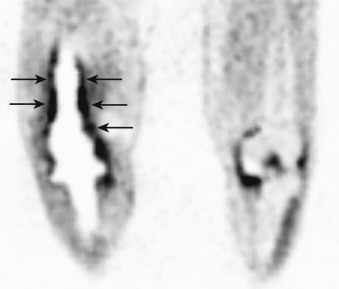Physical Address
304 North Cardinal St.
Dorchester Center, MA 02124
For the answer, see Box 77-1 . The applications in nononcological cardiac and brain disorders will be discussed separately in Chapters 82 and 83 , respectively.
Assessment of patients with brain disorders
Refractory seizures
Neurocognitive disorders
Assessment of patients with cardiac disorders
Myocardial viability
Myocardial sarcoidosis
Assessment of patients with suspected infection
Fever of unknown origin (FUO)
Infectious endocarditis
Osteomyelitis
Implanted device infection
Assessment of patients with noninfectious inflammatory disorders
Atherosclerosis
Vasculitis
Venous thromboembolism
Sarcoidosis
Interstitial lung disease (ILD)
Acute lung injury (ALI)/adult respiratory distress syndrome (ARDS)
Chronic obstructive pulmonary disease (COPD)
Inflammatory bowel disease
Psoriasis
Joint disease
Assessment of alterations in tissue metabolism
Skeletal muscle
Brown fat
FDG PET/MRI is most promising for the evaluation of patients with nononcological disorders that involve anatomic sites that are suboptimally evaluated at CT. In particular, PET/MRI may be particularly useful for evaluation of patients with neurologic, cardiovascular, and musculoskeletal nonneoplastic disorders. Available functional techniques afforded by MRI can further enhance detection and characterization of lesions. PET/MRI reduces radiation exposure compared to PET/CT, which is highly desirable, especially for pediatric patients and for those who undergo multiple examinations.
FDG PET is useful to detect infections that are not detected by other methods, to determine the spatial extent and severity of infections, and to monitor the effects of therapeutic interventions. Bacterial, mycobacterial, viral, fungal, and parasitic infections typically reveal areas of increased FDG uptake, which is related to the activation of neutrophil granulocytes and other inflammatory cells. Examples of specific applications of the potential utility of FDG PET in patients with suspected infection include the following:
Fever of unknown origin (FUO) is a challenging diagnostic problem, where early diagnosis of the underlying etiology is critical for appropriate patient management. Infection accounts for approximately one third of cases of FUO, followed by noninfectious inflammatory disorders and neoplastic disease. FDG PET has a high accuracy (>90%) to detect the underlying etiology of FUO and may be considered in the workup of patients with FUO for whom conventional diagnostic testing has been unsuccessful.
Infectious endocarditis is a serious infection that is associated with increased morbidity and mortality. FDG PET is useful to detect infectious endocarditis, even in the presence of a prosthetic valve which may limit the diagnostic performance of echocardiography, and to improve the specificity of diagnosis, as not all vegetations detected on echocardiography are infected. On FDG PET, increased FDG uptake in or around a cardiac valve is suggestive of infectious endocarditis.
Osteomyelitis, the infection of bone, requires timely diagnosis for early initiation of antimicrobial and surgical treatment to improve clinical outcome. FDG PET is useful to improve the early detection of osteomyelitis and has high diagnostic accuracy. In contradistinction, structural imaging techniques such as radiography, CT, and MRI may not reveal morphologic findings in early osteomyelitis and often do not reveal morphologic findings that are specific for early disease, particularly when preexisting alterations in the underlying osseous structures are present from prior trauma, surgery, or infection. Available conventional nuclear medicine techniques also have limitations in sensitivity and specificity of diagnosis. Presence of a preexisting metallic implant such as a joint prosthesis further limits the diagnostic capability of CT and MRI due to beam hardening and susceptibility artifacts, respectively. On FDG PET, increased FDG uptake in bone is suggestive of osteomyelitis, and increased FDG uptake along the prosthesis bone interface is suggestive of prosthesis infection ( Figure 77-1 ).

Become a Clinical Tree membership for Full access and enjoy Unlimited articles
If you are a member. Log in here